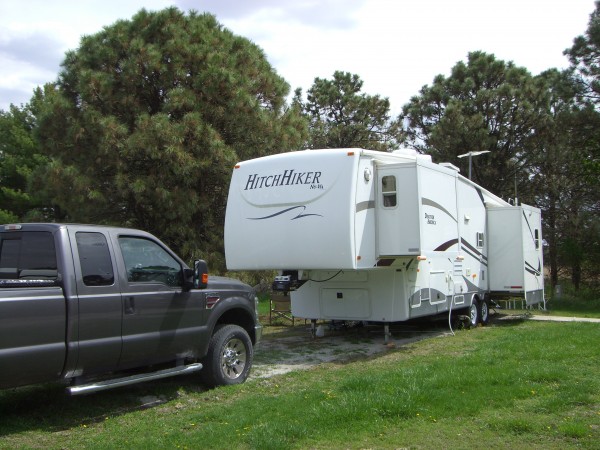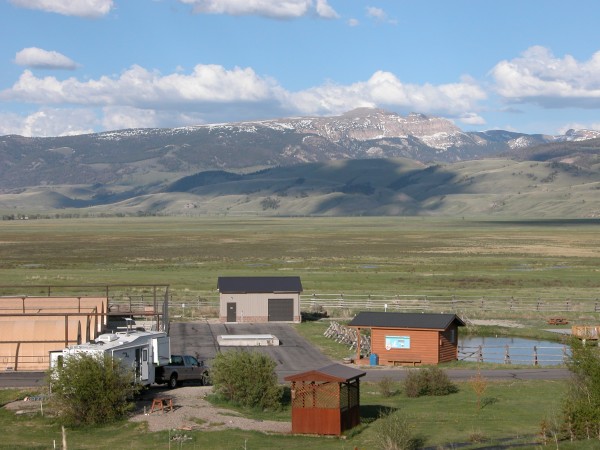“Do you live out in the wild?” The fourth grader who asked this as we finished a classroom presentation to prepare his class for their fieldtrip to Imperial National Wildlife Refuge appeared quite serious. We weren’t sure how to handle the question.

On one hand, living in a spacious RV with many amenities could be considered luxury, far from hardship associated with “wild.” On the other hand, some might consider living in the open spaces of a wildlife refuge as adversity and privation.
Living on a wildlife refuge isn’t for everyone. For us it means fresh air, great views, space, and interesting work. For others it can mean isolation, loneliness, hardship, and drudgery. Not everyone is comfortable living miles from doctors and groceries, surrounded by wildlife and secluded from society. Comments from our friends and acquaintances range from, “How can I get to do what you’re doing?” to “Are you nuts?”
While not all wildlife refuges are remote, we prefer those close to nature and far from big cities. Shopping has never been a priority for either of us, and our needs are few since we live in our RV and have most everything we want. Enough groceries can be stored after a once-a-week trip to town, and anything else can either wait or come by mail after placing an order on Internet. We do our best to avoid medical issues by maintaining a healthy lifestyle of proper diet and exercise. While this does not address every medical need, we rationalize the trade-off of possible medical problems with the freedom of living “away from it all.”
Wildlife Galore
Waking each morning to unlimited views and coyotes yipping or sandhill cranes chortling is just one advantage that lures us to this lifestyle. And spotting wildlife is expected on wildlife refuges. A bobcat once ambled by as we sat with a glass of wine behind our trailer. At the National Elk Refuge in Jackson Hole, a moose and her calf once worked their way across the Refuge toward the volunteer campground and finally slipped between two RVs before heading up the hill behind us. Gila woodpeckers, Gambel’s quail, yellow headed blackbirds, white pelicans, and even trumpeter swans are a few of the birds of all kinds that surround us at different refuges. And we regularly observe elk, deer, pronghorn, bighorn sheep, and small mammals. But because our main interest is reptiles, the thrill for us is searching for snakes and lizards of all species.
Living on a wildlife refuge also means taking care. In bear country, we must place garbage in special waste containers to avoid luring bears into human territory. In snake country, we must carry flashlights at night to avoid stepping on a rattlesnake after dark. While hiking in remote areas alone we carry first aid supplies, extra water, and a radio. And on any wildlife refuge, we must remember that wildlife comes first. We don’t interfere with it, and that includes not putting up bird feeders or artificially feeding other species.

Most wildlife refuges where we have volunteered have access to ponds, lakes, or rivers to launch our canoe and paddle backwaters in solitude, searching for and observing wildlife. All refuges have or are near hiking trails we can explore without traveling great distances. Some are near bike trails or allow biking within their confines. In all of these activities, we find ourselves fairly isolated in the midst of wildlife on mostly pristine lands.
So how to answer the fourth grader who asked if we live in the wild? After reflecting for a moment, I slowly nodded my head. “Yeah,” I said, “I guess we do.”
Living in our RV makes it possible. And for us it’s great!




Hey you Guys!!! Did an image search for the National Elk Refuge and came across your AMAZING website. Keep up the good work, Na I hope things are going well.
Thanks for the great comments! The blog really helps to define our passions and demonstrates what we enjoy doing. USFWS is the best group to volunteer with. We feel like family knowing both the staff and other volunteers. Wish you were here!
yes, we totally agree with you!!
Hey…articles like this are gonna make it hard to find my next gig. Everybody’s gonna want in on it 😉
Seriously I’m enjoying your web site. I came upon it doing snake research. I’m currently in my second spring/summer season volunteering on a C. atrox study in the Bosque del Apache NWR in South central New Mexico. I didn’t have any snake experience before I started with the project but I’m having a great time learning and appreciating them.
I’m in my 6th year of fulltime RV volunteering and everything you say about it is true. An awesome lifestyle.
Glad you liked the article! We, too, are in our 6th yr RV volunteering. Presently at the Nat’l Elk Refuge in Jackson WY. Will return to Imperial NWR, north of Yuma in Oct. The Tetons are a pretty area, but a herpetological desert with only 12 species of herps, most of which are frogs, toads, and one salamander. I’ve helped with a project with C. viridis in Colorado, so I know you’re enjoying the atrox activity. /Those scaly guys need all the friends they can get!
Thanks again for all the nice comments on our website. It’s fun to do and is a real learning experience. We may hook up someday down the road, so keep me posted on your adventures.
Chuck refuge42@yahoo.com
Today is March 14 Terry & Diane told us how great your refuge was & we went on a tour with Chuck & Betty at the Imperial wildlife refuge. You both are so wonderful and patient . What an amazing place & the educational part along the trail was great. Made me think & look at the tiniest of nature with a new understanding. Your knowledge & presentation can never be replaced. Bless you both.
Thanks for the kind words! And, we love sharing whatever we’ve learned over the past many years with folks who echo our interest and passions within the natural world. It is a true symbiotic relationship!